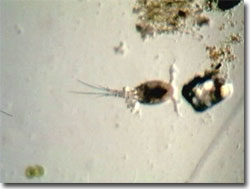Pond Life Digital Movie Gallery
Cyclops (Crustaceans) Movies
Recalling the mythological one-eyed giants of Homer's Odyssey, Cyclops are predominantly free-living crustaceans in the subclass Copepoda and the suborder Cyclopoida, and feature a central, anterior eyespot. Although largely marine, the specimen illustrated here is one of the 44 species of freshwater cyclopoids known from this genus worldwide.

Cyclops Video #1 - Two Cyclops move in and out of the field of view; under oblique illumination with a playing time of 17 seconds. Choose a playback format that matches your connection speed:
Cyclops Video #2 - Several Cyclops copepods (and a much larger mite) swim across the viewfield; under oblique illumination with a playing time of 30 seconds. Choose a playback format that matches your connection speed:
Cyclops Video #3 - A Cyclops appears to forage on a large piece of debris; under oblique illumination with a playing time of 38 seconds. Choose a playback format that matches your connection speed:
Cyclops filter-feed on algae and other microscopic material as they swim through the water column. Although not providing a high-resolution image, the single eyespot reacts to light intensity, increasing the likelihood that the one-eyed copepod will swim into areas dense with algae and other plankton. Diurnal vertical migrations of this micro crustacean provide a balance between feeding in the photic zone and avoidance of predation in the aphotic zone of a pond, lake, or ocean. The eye may be red or black and the body segments may be green, orange, blue, or red, depending on the species, the environmental conditions, and the invertebrate's nutrition. As with other copepods, there are 11 pairs of appendages on the head and thorax. Unlike their other copepod relatives, cyclopoids feature a forked tail filament known as a furca, and do not have compound eyes or a carapace. Females are often observed while swimming to have paired egg sacs, and most of the species are capable of explosive outbreaks when the water temperature and other conditions are optimal. Four species in Texas and three in Indiana are adapted for cave life typical of karst topography.
As the intermediary hosts of numerous human parasites such as the long (600 to 800 millimeters in length) Guinea worm (Dracunculus medinensis), cestodes such as the fish tapeworm that may plague sushi-lovers, and nematodes (roundworms) responsible for gnathostomiasis, Cyclops populations are sometimes subject to extensive eradication campaigns. This is especially true in underdeveloped nations lacking good sanitation and water quality. Alternatives to pesticides for controlling Cyclops as a disease vector involve manipulating the aquatic habitat to make it less favorable for the host crustacean or introducing efficient predators. Some species of Cyclops are not free-living, existing instead as fish parasites. Tropical and native fish enthusiasts utilize the cyclopoids as a high protein live fish food, especially for immature fishes, and in a fair twist of fate, some Cyclops species have been found feasting on larval fishes, particularly in fish hatcheries.
Contributing Authors
Cynthia D. Kelly, Thomas J. Fellers and Michael W. Davidson - National High Magnetic Field Laboratory, 1800 East Paul Dirac Dr., The Florida State University, Tallahassee, Florida, 32310.
BACK TO THE DIGITAL IMAGE GALLERIES
BACK TO THE OLYMPUS MIC-D DIGITAL MICROSCOPE
Questions or comments? Send us an email.
© 1995-2025 by Michael W. Davidson and The Florida State University. All Rights Reserved. No images, graphics, software, scripts, or applets may be reproduced or used in any manner without permission from the copyright holders. Use of this website means you agree to all of the Legal Terms and Conditions set forth by the owners.
This website is maintained by our
Graphics & Web Programming Team
in collaboration with Optical Microscopy at the
National High Magnetic Field Laboratory.
Last Modification Friday, Nov 13, 2015 at 02:19 PM
Access Count Since September 17, 2002: 28027
Visit the website of our partner in introductory microscopy education:
|
|
